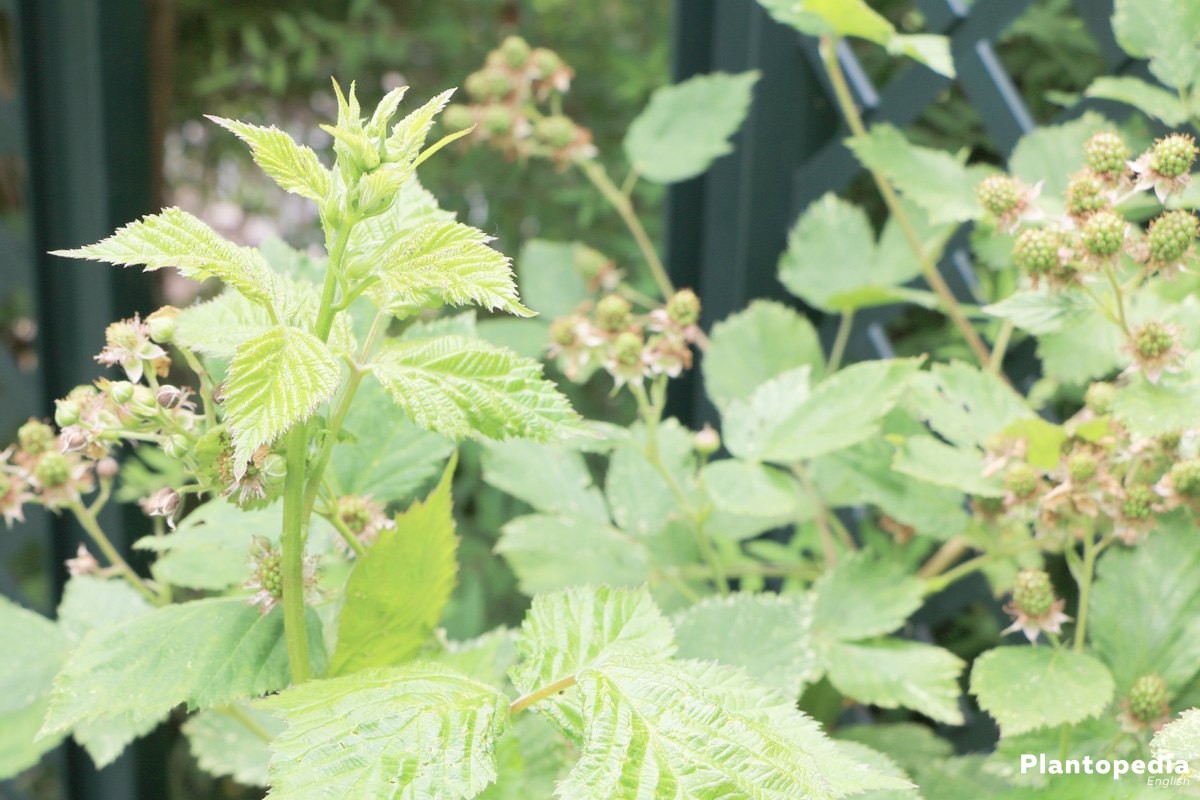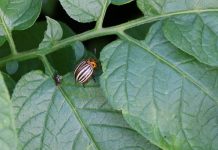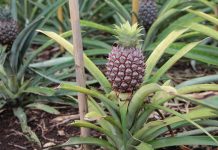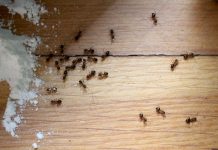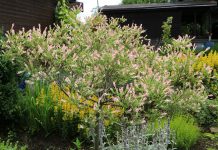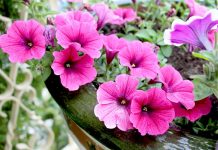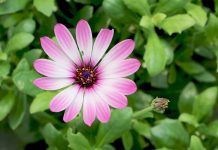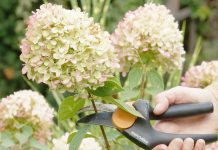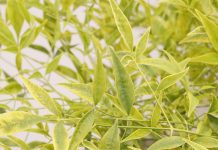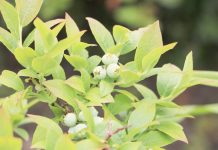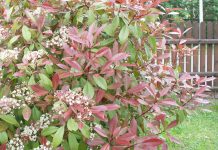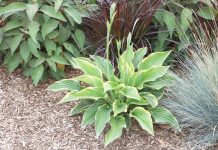Due to their blue-black colour, blackberries have a somewhat magical aura. Their fruity aroma and seductive fragrance are reminiscent of happy summertimes in grandma’s garden. Now it’s time for you to grow the delicious blackberries by yourself. Modern varieties are neither gruff nor demanding, as long as you take a closer look at the matter. Here you will find information on recommended varieties, professional care and cutting.
Plant Profile
Contents
- genus within the family of the rose plant
- description of the section: Blackberries (Rubus sectio Rubus)
- native in Europe, North Africa and North America
- herbaceous to lignified, deciduous berry bushes
- climbing tendrils as spreading climbers with and without thorns
- strong annual growth of up to 100 cm
- growing lengths and heights in cultivation from 50 to 300 cm, in nature even more
- intermittent green feathery leaves with a dark red autumn color
- twigged, white or pink flowers from May to August
- black-blue berry fruits (aggregate of drupes) from July to October
- trivial names: blackberry, bramble
Blackberry shrubs always bloom and bear fruit on the two-year-old shoots. These bear berries once and then die off. Meanwhile, the shrub will already produce numerous new rods, on which blossoms and fruits will thrive in the following year.
Care
If you are nibbling on fruity, juicy, warm blackberries right from the shrub in the summer, you have done everything right in the cultivation. Before getting there, you have selected your personal favorite variety, found the ideal location and perfectly planted and cared for the shrubs.
We have collected all-important informations for a successful cultivation of blackberries right here for you. Explore a selection of the best varieties. The care instructions cover all relevant aspects from the correct watering and fertilization to the skilful cutting of the home-grown berry shrubs.
Varieties
In the cultivation of blackberries you can benefit from a great experience, which is reflected in the range of tried and tested varieties. Innovative new sorts are also available, motivating you with their vital yield capacity and even doing without the annoying thorns. The following selection presents you with recommended varieties.
Theodor Reimers
- this historical variety still surpasses most newcomers in the blackberry family with regard to growth and yield
- from the end of July to the end of September this classic offers you a rich harvest of aromatic, sugar-sweet fruits
- Special feature: ideal for fresh consumption
Lubera Navaho
- from the middle of July onwards, this thornless variety produces large blackberries, which will treat your palate with an expressive aroma
- in addition to its high yield capacity, this innovative variety scores with a decent resistance to powdery mildew
- Special feature: does not necessarily need a trellis
Loch Ness
- Blackberry experts and lovers agree that this variety is one of the best cultivation successes
- from the beginning of August, you will reap voluminous blackberries of excellent taste without thorns hindering your work
- bees and butterflies are looking forward to the early flowering period from April onwards, since a lush yield of nectar is offered by this variety
- Special feature: barely prone to fruit rot
Arkansas Navaho
- even in a small garden you won’t have to do without the fruity-fresh blackberry pleasure
- this thornless column-blackberry invites you to nibble on its aromatic fruits from July on
- the slender growth is far less extensive than in the case of the other varieties
- Special feature: suitable for cultivation in the bucket
Cultivation
Blackberries have been an integral part of the farm and garden for generations, because they are robust and uncomplicated. To ensure that you’ll have a rich berry harvest every year, you should note several important details. By choosing the ideal variety as planting material in the best quality, you already set the course in advance.
A careful soil preparation at the adequate location in conjunction with the appropriate planting technique will pave the way to your fruity-fresh berries. In the following, we will provide you with the gardening know-how needed to successfully grow blackberries.
Quality
Criteria of best planting material
If you have found your favourite varieties, you should focus on the quality of the young plants. Tree nurseries and garden centers offer blackberries with root balls mainly, because they can be planted almost all year round. Before buying the planting material, test it for the following criteria to make sure the blackberry plants in your garden will have the best quality.
- at least 3 richly green, healthy shoots
- no injured or dried bark
- well rooted ball, without long twisted roots at the bottom
- no or very little substrate is dropped when you take the plant off the pot
Do not be afraid to get the blackberry plant out of the pot before buying it, in order to observe the root ball according to the criteria mentioned above. A vital and vigorous young plant has, after proper care, the vitality for many years, so it is worth to take a close look.
Planting time
Blackberries with thorns that have been pre-cultivated in a container, can be put into the soil during the entire vegetation period, as long as the ground isn’t frozen. However, we recommend to plant them in spring. When in March and April the soil is warmed under the influence of the spring sun and is still moistened from the winter, the rooting will progress particularly fast.
Location
Location and soil
Blackberries primarily prove their undemanding tolerance with regard to the suitable location conditions.
The shrubs will thrive well in the following locations:
- sunny to half-shady spot
- prefering a warm and wind protected location near a house wall
- medium-heavy, humus-rich soil, fresh-humid and well permeable
- usually with a pH of 4.5 to 6.0
Loosen the soil thoroughly to prepare the planting. If the soil does not meet the requirements for a yielding cultivation, add leaves compost or bog bedding and rake the material into the soil surface.
Planting
Before you place a blackberry shrub into the bed, you should soak the root ball in horsetail-broth for a few minutes. If the root ball is very dry, put it in soft water for 20 to 30 minutes until no more air bubbles rise.
Correct planting of the blackberry-shrub is done as follows:
- each planting pit should be twice the volume of the root ball
- the planting distance is 100-150 cm for low-growth and 300-400 cm for high-growth varieties
- mix the extracted soil with sieved leaf compost
After taking a young plant out of the pot, you should plant it so deep that the surface of the root ball is 5 cm below the ground level. Press the substrate well and pour it generously with soft water, but take care that no waterlogging occurs. In the last step you spread a 4-5 cm layer of bark or compost, which keeps the soil from drying out and keeps it warm.
The right trellis
The proper cultivation of blackberries requires – with a few exceptions – the fixation of the tendrils on a trellis. This additional effort is rewarded in more than one way: even in the case of very strong growing blackberry varieties, there is a clear order in the bed and there is no impenetrable tendril jungle that can only be controlled by a radical cut.
In addition, all maintenance measures as well as the cutting back are much easier. The construction does not require any special crafting skills and can be installed very quickly.
This is how it’s done:
- install a head-high wooden plank into the ground on both ends of the blackberry bed
- tighten a first wire at a height of 50 cm above the ground
- attach additional wires at intervals of 30-40 cm
Adjust the size of the climbing aid to the planted varieties. A fast growing, ardent Theodor-Reimer-blackberry requires a bigger trellis than a slowly growing, thornless Navaho.
Where the basic conditions of the location correspond to the requirements of a blackberry, the maintenance effort is low.
This is how you properly care for your berry shrubs:
- pour the plants when it’s dry
- preferably pour them with collected rain water or stagnant tap water
- in April, fertilize with foliage compost, rotted horse dung or bark humus
- alternatively, spread a special berry fertilizer and slightly rake it into the soil
The blackberry has a robust winter hardiness, which, however, develops only in the course of the first standing years. In the year of planting, we therefore recommend to protect the bed from frost with autumn leaves and brushwood. The young rods will be grateful for a protective wall made of bast mats. Alternatively, you can arrange brushwood around them.
Cutting
Cutting on the trellis
On a blackberry shrub, cutting and training go hand in hand. To this end, bind the young rods to the trellis, proportionally to the progress of their growth. For slowly growing varieties the fan shape training has proven its worth. Fast growing blackberry varieties will thrive optimally, when their tendrils are trained to palmettes on the wires. Please remember to pay attention to this procedure when you are cutting them back.
- in the first summer, attach 4 to 5 strong rods on the trellis
- cut all other shoots close to the ground
- in the autumn or late winter you should untie the empty fruit shoots and cut them off at the base
- the lateral branches of the young rods should be shortened to 20 or 30 cm or 2 to 3 buds
- place the cut 1 cm above a bud
- loosely tie the trimmed rods to the wire again
- don’t cultivate more than 2 to 3, maximum 5 rods per planting area, cut the others just above the ground
This cutting procedure implies that you can clearly distinguish old and young tendrils. This is not always possible without a doubt, but we can help you with this trick: fix the rods separately from each other on the training system.
After one year the fruit-bearing rods are on the right side and the young tendrils are on the left side. While in the further course the left-sided rod bears fruit, you can train the next generation on the right side.
Cutting column blackberries
The innovative, upright-growing blackberry varieties enrich the small gardens with their flower and berry splendor, as they claim a maximum of one square meter of cultivation space. In this case, 2 to 3 of the strongest young rods are tied to a bamboo stick and trained vertically upwards. All other shoots must retreat.
This is how you properly cut column-blackberries:
- at the end of February / beginning of March, shorten all lateral shoots on the rods until only 2 buds remain
- these will form this year’s shoots, which will bloom and bear fruit on their ends
- in September, after the harvest, you must cut the empty rods back to 10 cm
- train this year’s tendrils on the bamboo again
If the rods grow over you during the summer, the experts advise against cutting them back. A cutback in the middle of the vegetation period encourages the blackberry bush to grow lateral shoots again, which is connected with an unnecessary effort. Only in February you should shorten the shrub to the desired height.
Multiplication
The blackberry impressively demonstrates its uncomplicated character when it comes to the multiplication. In particular, two methods of vegetative cultivation have proven to be practicable, they are explained below in more detail.
Cuttings
Partlings of one-year-old tendrils are suitable as cuttings, but only from the tendrils that do not bloom or bear fruit this year. For this purpose, cut off 10 cm long terminal cuttings in the early summer, which have 2 to 3 sleeping buds. Other shoot parts are also suitable, but they won’t have the growth vigour of terminal cuttings.
With the following information, the multiplication with cuttings will succeed:
- defoliate every cutting until only one pair of leaves remains
- put the lower two-third of each cutting into a pot with moist peat sand or cultivation soil
- keep it slightly moist under a plastic bag or in the greenhouse
Within 3 to 4 weeks a new root system develops, then fresh leaflets will sprout. The coverage can now be removed or the greenhouse can be left again, because fresh air and sunshine promote the growth. Keep pouring it regularly with soft water, without using any fertilizer.
If a cutting has completely rooted its cultivation pot, please put it into a larger bucket with nutrient-rich, well-permeable substrate. After another 4 weeks in the sunny, warm place in the garden, the cutting will have turned into a vital young plant and can be planted into the bed in autumn.
Layers
The flexible tendrils of a blackberry allow the propagation by layers. To this end, choose a shoot from this year in March or September and pull it to the ground. Put the tip into a 6 cm deep hole that you have drilled with a wooden stick. Press the soil and fix the rod with a wire hook, if it wants to jump up again. Within a few weeks, a new root system develops on the layer, because the mother plant continues to supply the offspring with nutrients.
If you feel a stable resistance when pulling on the young plant, excavate it and separate it from the mother plant with a sharp cut. In a sunny to half-shady spot, you can plant the new blackberry shrub into nutrient-rich soil, shorten the shoot to 20-30 cm and pour it.


